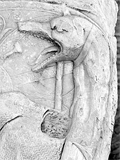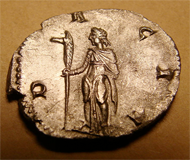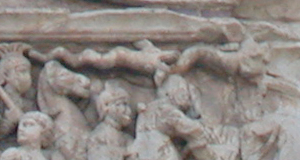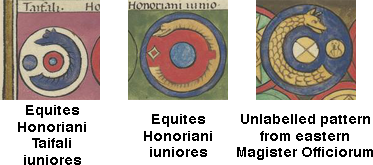
This page created 20 April 2014, and last modified: 3 December 2015 (Maier reference numbers added)

The Honoriani iuniores is listed (102/5.38 in Ingo Maier's numbering scheme) as the 26th of the vexillationes comitatenses in the Magister Equitum's cavalry roster; it is assigned (102/5.249) to the Comes Africae as the Equites Honoriani iuniores. Its shield pattern (101#16), as shown in various manuscripts under the label (101.q) Honoriani iuniores, is as below:

The shield pattern shows a red ground with a large blue boss. The rim of the shield appears to be purple (faded to maroon in M, W; indigo in P). Two other features appear - a small mascle (voided lozenge) at the 9 o'clock position (3 o'clock in P, which reverses its shield facings), and a yellow draco - a military standard that was introduced to the Roman forces during the 2nd century AD as a result of the Dacian wars, and which became more popular with time, to judge from e.g. Vegetius, in which a cohort is given its own standard, kept by a draconarius. Despite the name "draco" (serpent, dragon), illustrations of dracones often seem to feature a head that looks more wolf-like than serpent-like.

|

|

|
|
|
|
|
|
|
|
|
Although many units bear such dracones in the Notitia, this one is unique in apparently having a small rectangular section cut out of it opposite the mascle. This unit's combination of draco and mascle shield pattern has been interpreted as early evidence for the "dragon and pearl" motif in western art that is usually associated with China. Although this east-west connection looks initially plausible given the appearance of apparent (but misleading) "yin-yang" symbolism in the Notitia, e.g. with the pattern of the Mauri Osismiaci (98/9.142), it loses force when one considers that the patterns of units in which a much more pearl-like disc is shown, instead of a mascle, are intended to represent an imago - an imperial portrait. This can be seen by comparing the pattern of Equites Honoriani iuniores with the similarly-named Equites Honoriani Taifaili iuniores (102/5.18) and an unidentified pattern (106#5) associated with the western Magister Officiorum. These shields are shown below, using the patterns taken from the Paris manuscript:

Thus the small mascle might originally have been an imago of some description in the real life. A small rectangular imago is shown in in the patterns of other units illustrated in the Notitia (e.g. the Sagittarii seniores Gallicani, 9.29), and this one may have just been rotated somewhat from its proper orientation (alternatively, perhaps a lozenge was a proper orientation for one kind of imago). Such portraits had long been used as the components of Roman standards, so associating one form of standard - a draco - with another - an imago - might be appropriate (note that vexillationes in vexillationes comitatenses, the unit category that the Equites Honoriani iuniores belongs to, refers to yet another type of Roman standard; a vexillum being a small flag hung from a cross-bar).
Note that there is also another unit listed (102/5.23) as the Equites Honoriani iuniores in the Notitia, in the Magister Equitum's Gallic command, which more likely refers to the Equites Honoriani Taifali iuniores mentioned above rather than the unit being discussed here, for two reasons. The first is because of the connections some historical Taifali are known to have had with Gaul but not with Africa. The second is an otherwise unknown Equites Taifali listed (102/5.256) under the Comes Britanniarum, which would appear to be one and the same as the Equites Honoriani Taifali iuniores.
The name Honoriani commemorates Flavius Honorius Augustus, who became the western Roman emperor at the age of 10, in 395 AD (he had been declared co-emperor even earlier), and who died in 423 AD. As a consequence, a great many western units bear his name. Cavalry units with related names are the Equites Honoriani Taifali iuniores already mentioned above, and the Equites Honoriani seniores (102/5.19), apparently assigned to both the Magister Equitum's Gallic command(102/5.222) and the Comes Britanniarum (102/5.253).
1. Ingo Maier; "Appendix 4: Numeration of the new edition of the compilation 'notitia dignitatum' (Cnd)"; last accessed 26 October 2015. See also for here for numbering examples. Return
2. Publius Flavius Renatus Vegetius ("Vegetius"); "Epitoma rei militaris", 2.13; available here in Latin and here in English (last accessed 3 December 2015). Return
3. Helmut Nickel; "The Dragon and the Pearl"; Metropolitan Museum Journal, Vol. 26, (1991), pp. 139-146; available here (last accessed 3 December 2015). Return
4. Georgius Florentius Gregorius ("Gregory of Tours"); "Decem Libri Historiarum" (Historia Francorum); 4.13; available here in Latin (last accessed 3 December 2015). Return

Return to the Notitia alphabetical unit list page.
Return to my Notitia index page.